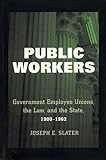Public Workers : Government Employee Unions, the Law, and the State, 1900–1962 / Joseph E. Slater.
Material type: TextPublisher: Ithaca, NY : Cornell University Press, [2017]Copyright date: ©2016Description: 1 online resource (272 p.)Content type:
TextPublisher: Ithaca, NY : Cornell University Press, [2017]Copyright date: ©2016Description: 1 online resource (272 p.)Content type: - 9781501707483
- 330
- online - DeGruyter
| Item type | Current library | Call number | URL | Status | Notes | Barcode | |
|---|---|---|---|---|---|---|---|
 eBook
eBook
|
Biblioteca "Angelicum" Pont. Univ. S.Tommaso d'Aquino Nuvola online | online - DeGruyter (Browse shelf(Opens below)) | Online access | Not for loan (Accesso limitato) | Accesso per gli utenti autorizzati / Access for authorized users | (dgr)9781501707483 |
Frontmatter -- Contents -- Acknowledgments -- Introduction -- 1. The Boston Police Strike of 1919 -- 2. Yellow-Dog Contracts and the Seattle Teachers, 1928-1931 -- 3. Public Sector Labor Law before Legalized Collective Bargaining -- 4. Ground-Floor Politics and the BSEIU in the 1930s -- 5. The New York City TWU in the Early 1940s -- 6. Wisconsin's Public Sector Labor Laws of 1959 and 1962 -- Conclusion -- Notes -- Selected Bibliography -- Index
restricted access online access with authorization star
http://purl.org/coar/access_right/c_16ec
From the dawn of the twentieth century to the early 1960s, public-sector unions generally had no legal right to strike, bargain, or arbitrate, and government workers could be fired simply for joining a union. Public Workers is the first book to analyze why public-sector labor law evolved as it did, separate from and much more restrictive than private-sector labor law, and what effect this law had on public-sector unions, organized labor as a whole, and by extension all of American politics. Joseph E. Slater shows how public-sector unions survived, represented their members, and set the stage for the most remarkable growth of worker organization in American history. Slater examines the battles of public-sector unions in the workplace, courts, and political arena, from the infamous Boston police strike of 1919, to teachers in Seattle fighting a yellow-dog rule, to the BSEIU in the 1930s representing public-sector janitors, to the fate of the powerful Transit Workers Union after New York City purchased the subways, to the long struggle by AFSCME that produced the nation's first public-sector labor law in Wisconsin in 1959. Slater introduces readers to a determined and often-ignored segment of the union movement and expands our knowledge of working men and women, the institutions they formed, and the organizational obstacles they faced.
Mode of access: Internet via World Wide Web.
In English.
Description based on online resource; title from PDF title page (publisher's Web site, viewed 26. Apr 2024)


